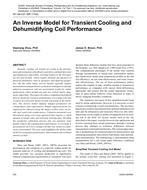Description
Dynamic cooling coil models are useful in the development and evaluation of feedback controllers and fault detection and diagnostics algorithms. Existing models in the literature are forward models, which require detailed specification of physical parameters such as geometry and material properties. On the other hand, inverse models typically require measurements and parameter estimation techniques to identify unknown parameters and are particularly useful for online applications where models are part of a control and/or diagnostic algorithm. This paper develops a simplified distributed inverse model for transient performance of cooling coils that is based on a forward model recently presented in the literature. The inverse model employs lumped parameters for conductances and capacitances. Simple empirical forms are employed for characterizing the impact of flow rates on airside and water-side conductances. Unknown parameters are determined using a two-step approach that requires a small amount of steady-state and transient training data. Dividing the parameter estimation process into two separate steps greatly reduces the training data requirements. A case study is presented for an 8-row cooling coil that was tested in a laboratory environment. The case study highlights the ability of the model to extrapolate performance when trained with a limited amount of data.
Units: SI
Citation: ASHRAE Transactions, vol. 114, pt. 1, New York 2008
Product Details
- Published:
- 2008
- Number of Pages:
- 11
- File Size:
- 1 file , 3.7 MB
- Product Code(s):
- D-NY-08-037




